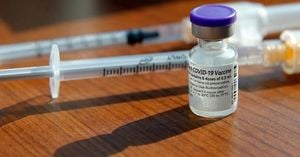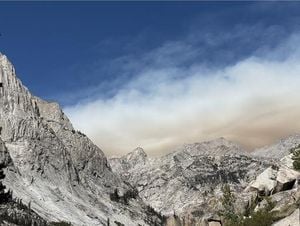The threat of eastern equine encephalitis virus (EEEV), commonly referred to as Triple E, has made headlines as health officials in New England raise alarms about the dangerous mosquito-borne disease. Recently, the normally quiet town of Sudbury, Vermont, joined the ranks of regions classified as 'high risk' after the virus was detected, igniting concerns among residents.
Sudbury, with its few hundred inhabitants, was added to the state's warning list, which also includes places like Burlington, Alburgh, Colchester, and Swanton. Health authorities advised local residents to take precautions against exposure to this largely uncommon but potentially fatal disease, which has also been reported across several New England states and even as far as Wisconsin.
The perception of Triple E as merely another exotic illness is far from the reality many health officials face. The seriousness of EEE cannot be overstated; it consistently leads to severe health complications. The New Hampshire Department of Health and Human Services announced last week the tragic death of a 41-year-old man from Hampstead, who succumbed to the disease after being hospitalized for acute central nervous system issues. This marked New Hampshire’s first human case of EEE since 2014 and underscored the need for greater public awareness.
Public health officials are taking this situation seriously as signs of potential outbreaks become evident. Vermont Governor Phil Scott remarked, "Obviously, this disease is dangerous, but it’s not widespread at this point. We should acknowledge it’s there and take precautions." Throughout Massachusetts, similar sentiments echo, where state officials initiated insecticide spraying to combat the virus, which has been identified as negatively impacting human health.
Historically, EEE has been seen as sporadic, with the first recorded outbreak dating back to the 1830s. Originally detected among horses, the focus shifted to mosquitoes as vectors by the mid-1930s. This viral infection doesn't discriminate, affecting humans and horses alike. The consequences can be dire, with reports indicating about 30-40% mortality among infected individuals. Alarmingly, half of those who survive are left with lasting neurological damage. Therefore, swift preventive action is what public health officials are currently advocating.
Recent outbreaks have shown fluctuations over decades, but the incidence appears to be on the rise again. Between 1964 and 2002, cases were rare, but from 2003 to 2019, the average rose to four or five annually, primarily concentrated in the Northeast. Experts suggest the increase is closely tied to climate change, which has created more favorable conditions for mosquito breeding and longevity.
With rising temperatures and warmer, wetter weather, mosquitoes proliferate—in the case of EEE, primarily the Coquillettidia perturbans. This species picks up EEE from infected birds, primarily robins and herons, and transmits it to horses and humans via bites. Yet, environmental conditions play a significant role as they dictate when and how active these mosquitoes become. Tropical conditions coupled with human engagement with the outdoors put the general public at increased risk.
To combat EEE, Massachusetts recently placed ten communities under the label of 'critical risk.' Mosquitoes thrive particularly at dusk and dawn, prompting officials to restrict park hours and limit outside activity during those times. These precautions came after four human infections were identified this year alone across several states, including Vermont, which reported its first human case of the virus since 2012.
The symptoms of EEE typically appear four to ten days post-infection, presenting as severe flu-like symptoms and leading to encephalitis, which shows itself through seizures or altered mental status. On the health safety front, experts like Dr. Tim Lahey from the UVM Medical Center stress the importance of preventive measures like using insect repellent, wearing protective clothing, and avoiding outdoor activities during peak mosquito hours.
The discussion on EEE doesn't revolve solely around individual actions. The agricultural and commercial sectors also experience the consequences. Pest control companies like Vermont Pest Control have seen requests for mosquito spraying double as community anxiety builds. Ian Gordon, representing again, indicates the urgency felt by homeowners wishing to protect their families and properties—many fear the dangers these insects pose with rising reports of infection.
The state has occasionally resorted to aerial spraying, particularly for trouble spots, based on positivity rates among collected mosquitoes. No decisions have been made on similar measures for the current season, but public health directives have indicated they remain on standby.
A notable point raised by many health officials emphasizes not to panic, but to be aware. Dr. Edward Liu, chief of infectious diseases at Hackensack Meridian Jersey Shore University Medical Center, stressed the unpredictable nature of viruses like EEE and how their foreshadowed spread is often hard to predict. Environmental changes due to climate fluctuations are likely to create opportunities for EEE and similar viruses to cross boundaries previously untouched.
Meanwhile, aligned with recommendations from the CDC, residents are urged to act preemptively, keeping their surroundings free from standing water, which provides breeding grounds for mosquitoes. Effective strategies appear simple: maintaining landscaping, using EPA-certified insecticides, or ensuring proper drainage of outdoor areas. Simple means can often preempt larger-scale emergencies.
The spread of mosquito-borne diseases like EEE is no longer confined to traditional rural regions, with evidence now showing encroachment upon suburban and even urban areas. The relentless push of development and reforestation creates new habitats for disease vectors, marrying human habitation and nature increasingly closer.
While seasonal prevention remains the current focus, the advent of vaccines for different animal species does raise questions for future human protection. Although there’s little encouragement for vaccine developers to find solutions for EEE, the existing vaccine for horses highlights the potential path for future protective measures.
To summarize, Triple E's resurgence requires coordinated efforts across public health, private industry, and individual tackle to combat, prepare, and respond to the growing challenges posed by this mosquito-borne disease. The dual threat of seasonal behavior of mosquitoes and unpredictable viral outbreaks is something residents must remain vigilant of as climate transitions change the fabric of outdoor life and its associated risks. Awareness and swift action can potentially save lives.



